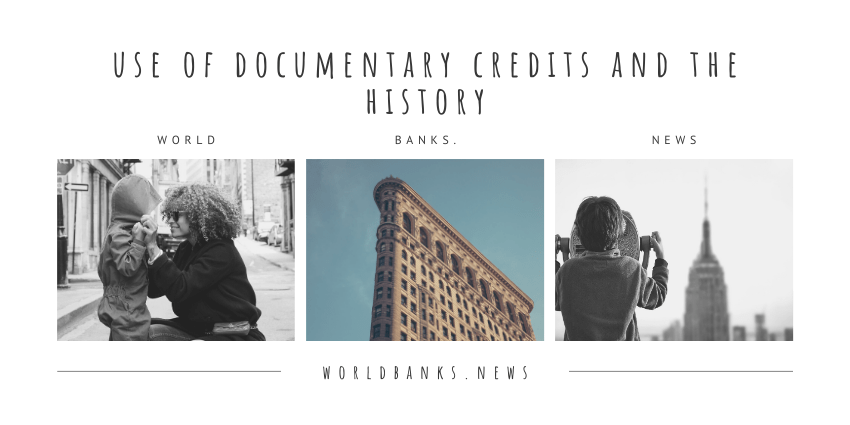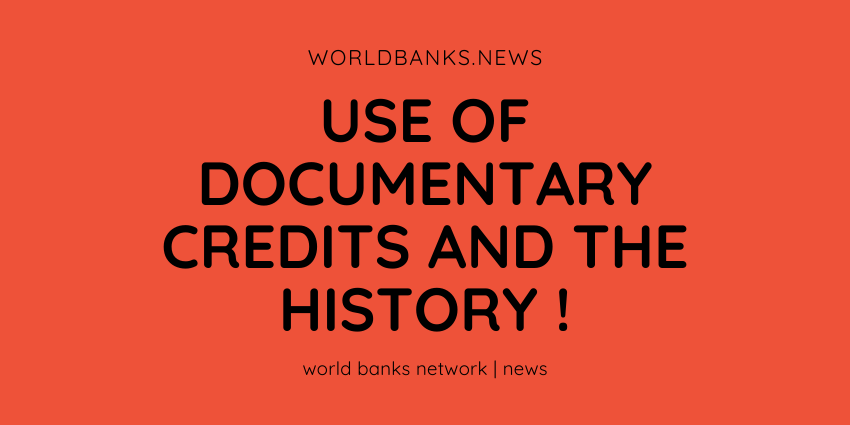Use of documentary credits and the history!
Learning objectives:
This chapter includes a brief history of the documentary credit, an
insight into currently available statistics (2013 data) and the types
of transaction for which a documentary credit is often chosen as the
method of settlement.
By the end of this chapter, you should be able to:
◆ describe the origins of a documentary credit; and
◆ understand the range of transactions for which a documentary
credit may be the chosen method of settlement.
A brief history:
Historians have been able to trace the use of documentary credits back
as far as ancient Egypt and Babylon. However, it was not until the 18th
and 19th centuries that the term ‘letter of credit’ became widely used and
recognised. During this period, it was common for merchants to seek out
new markets and to make use of the trading opportunities offered by such
markets. In order to provide their clients with a means of obtaining cash
during their overseas travels, banks in the Western world introduced the
concept of a traveller’s letter of credit. This document allowed bank clients
to avoid the need to carry large sums of money, which could be lost or
stolen.
In addition to the traveller’s letter of credit, it was usual for a formal letter
of introduction to be addressed to the bank’s overseas correspondent or
agent. This letter, usually sent in advance of travel, would indicate that the
client was a valued customer of the bank. It would also request that the
correspondent or agent provide the client with any necessary assistance.
A traveller’s letter of credit took the form, literally, of a letter. It indicated
that the issuing bank would honour bills of exchange drawn on it by the
correspondent or agent in respect of amounts paid to the named traveller,
plus any charges incurred by the correspondent or agent. There would also
be an indication of a maximum amount that could be drawn and an expiry
date.
Each correspondent or agent was required to indicate on the original
traveller’s letter of credit details of amounts paid and the relevant dates.
The client always retained possession of the original document.
It can therefore be seen that the origins of the documentary credit lay in a
‘letter’ provided by a bank to a correspondent or agent. Upon production
of that letter, ‘credit’ was provided to a named client in the form of money.
From the 1840s, documentary credits began to serve as a means of
facilitating payment for foreign trade transactions. It may well be that, as a
result of personal contacts made during their travels, merchants were able
to arrange for goods to be sent from overseas.
One of the oldest available examples of a traveller’s type letter of credit
can be found in the archives of the US Library of Congress. It was issued
in Washington on 4 July 1803 and signed by then President of the United
States, Thomas Jefferson. It was provided to explorers Captain Meriwether
Lewis and Captain William Clark as they departed on their famous expedition
through the western part of the United States.
The letter read as follows:
Washington. US. of America. July 4. 1803.
Dear Sir,
In the journey which you are about to undertake for the discovery of the
course and source of the Missouri, and of the most convenient water
communication from thence to the Pacific ocean, your party being small,
it is to be expected that you will encounter considerable dangers from
the Indian inhabitants. Should you escape those dangers and reach the
Pacific ocean, you may find it imprudent to hazard a return the same
way, and be forced to seek a passage round by sea, in such vessels
as you may find on the Western coast. But you will be without money,
without clothes, & other necessaries; as a sufficient supply cannot be
carried with you from hence. Your resource in that case can only be in
the credit of the US. for which purpose I hereby authorise you to draw on
the Secretaries of State, of the Treasury, of War & of the Navy of the US.
according as you may find your draughts will be most negociable, for the
purpose of obtaining money or necessaries for yourself & your men: and
I solemnly pledge the faith of the United States that these draughts shall
be paid punctually at the date they are made payable. I also ask of the
Consuls, agents, merchants & citizens of any nation with which we
have intercourse or amity to furnish you with those supplies which
your necessities may call for, assuring them of honorable and prompt
retribution. And our own Consuls in foreign parts where you may happen
to be, are hereby instructed & required to be aiding & assisting to you
in whatsoever may be necessary for procuring your return back to the
United States. And to give more entire satisfaction & confidence to those
who may be disposed to aid you, I Thomas Jefferson, President of the
United States of America, have written this letter of general credit for you
with my own hand, and signed it with my name.
Th: Jefferson
Prior to World War I, the use of documentary credits had become more
widespread, but – as is the case today – a large number of sales were made
without the support of a bank undertaking. As a result of the outbreak
of war, previously established trading chains were suddenly put under
the spotlight and either ceased completely or a bank undertaking, in the
form of a documentary credit, often became a prerequisite before goods
would be shipped or handed over to buyers. With new trading chains being
established of necessity, and with little or no available information on the
trading experience of any new counterparty buyer, exporters increasingly
looked to the documentary credit to secure their payment.
The use of documentary credits:
Documentary credit statistics:
The use of documentary credits as a method of settlement for a trade
transaction remains steady today. The International Chamber of Commerce
(ICC) Global Trade and Finance Survey Report, released in July 2014,
indicated that the volume of SWIFT MT700 messages (‘Issue of a Documentary Credit’) increased by 3.3 per cent between 2012 and 2013 (ICC, 2014).
Because the use of a SWIFT MT700 message is the most common form
of documentary credit issuance, SWIFT volume figures provide the only
reliable data on the use of documentary credits.
This increase contributed to an annual volume of 4,787,071 documentary
credit issuances during 2013 – an average of almost 399,000 issued
per month. The Asia-Pacific region continued to account for the bulk of
the documentary credit volume, with almost 70 per cent of the market
(ICC, 2014). Despite this increase, global volumes remain below those
experienced in the 1970s, 1980s and 1990s.
The Chinese renminbi (RMB) is now the second most-used currency, after
the US dollar (USD). The average value of a documentary credit issued in
2013 was USD653,000 – a 6 per cent increase on the 2012 figure.
Using a documentary credit:
Today, a documentary credit can be used for almost any situation in which
goods are being shipped, or services or performance are being provided.
This can range from multimillion-dollar, -renminbi, -euro, etc, building
projects to the shipment of a simple spare part for a machine or vehicle.
By far the most common type of goods falls into the category of ‘consumables,
clothing, food, (rice, wheat, sugar, etc.)’. However, transactions can equally
apply to more unusual items, such as the sale, lease or scrapping of a
vessel or aircraft and suchlike.
In some countries, local legislation will impose a requirement for the use
of a documentary credit for all, or certain, types of good that are imported.
This ensures that the import of the underlying goods will be subject to
specific terms and conditions that can mirror and / or comply with local
requirements.
Documentary credits are also used in some countries to support local
assembly industries. For example, a documentary credit will cover the
import of goods in a kit form. The staff of the local factory will put these
materials together to create a finished article. These can be goods such as
televisions, fridge freezers, motor vehicles, etc. The use of a documentary
credit allows for its terms and conditions to include details of when and
how certain components are to be shipped, in order to match the process
and workflow of the factory.
Provided that a shipment of goods or the provision of a service or
performance can be documented, and those documents can be presented
to a bank, it is possible for a documentary credit to be the method of
settlement.
Questions
1. One of the first forms of letter of credit introduced was known as which
one of the following?
A. A businessman’s letter of credit
B. An exporter’s letter of credit
C. A traveller’s letter of credit
D. A seller’s letter of credit
2. ‘Documentary credits have been in existence for only the past 300
years.’ Is this statement true or false?
A. True
B. False
3. What was the second most-used currency in documentary credits issued
using the SWIFT MT700 message in 2013?
A. The US dollar (USD)
B. The euro (EUR)
C. The pound sterling (GBP)
D. The Chinese renminbi (RMB)
4. What was the average value of a documentary credit issued by MT700
in 2013?
A. USD563,000
B. USD653,000
C. USD356,000
D. USD635,000
5. ‘A documentary credit can be used only for the purchase of consumables,
food and clothing, and for the provision of services or performance.’ Is
this statement true or false?
A. True
B. False
References
◆ ICC (2014) Global trade and finance survey report 2014, p44–45. Paris:
ICC.
The role of the ICC and the development of the UCP
Learning objectives:
This chapter provides an outline of the activities undertaken by the
International Chamber of Commerce (ICC) and an overview of how the
text of the Uniform Customs and Practice for Documentary Credits
(UCP) has developed across the six revisions that have occurred since
the first UCP was implemented in 1933.
In addition, some background information is provided to the rules that
existed prior to the development of the first UCP.
By the end of this chapter, you should be able to:
◆ describe the function and reach of the ICC; and
◆ understand the origins of the UCP and the development of its text.
Facebook Page
Shop Now
amazon special products























